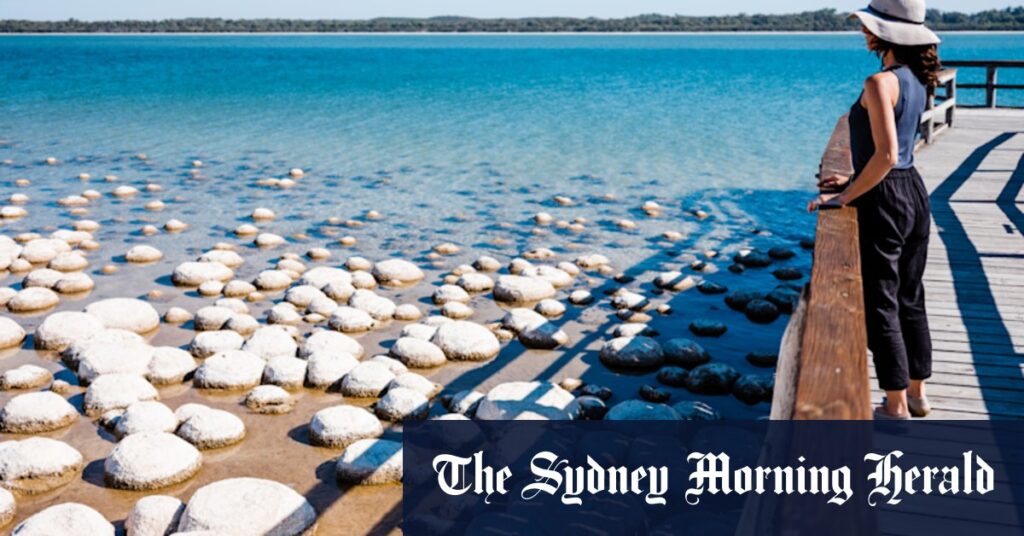“Western Australia is one of the world’s biodiversity hotspots, and to give fuller protection to our unique flora and fauna for generations to come the Department needs to take the next steps in its planning and operations and use the powers at its disposal to meet the obligations it has,” Spencer said.
Conservation Council of WA executive director Matt Roberts said the report confirmed that the government had its priorities wrong and was not resourcing its agencies to be effective.
The thrombolites on the edge of Lake Clifton are among Western Australia’s threatened ecological communities. Credit: Tourism Western Australia
“Western Australia is a wealthy state, with a $2.4 billion budget surplus – but our government is yet to seize the opportunity to protect what truly matters: the health of nature on which we all depend,” he said.
He said the recent budget prioritised streamlining assessments at the expense of monitoring and compliance, and it was clear the government did not understand the crisis our environment faced, or its importance to human wellbeing.
“The full and proper resourcing of our environment departments is critical,” he said.
“We strongly urge the government to elevate the environment on their priorities for this term.”
He called on the state to urgently review and strengthen the Biodiversity Conservation Act, fund and implement Recovery Plans for all threatened species and ecological communities.
“WA has not published a State of the Environment Report since 2007. The last Biodiversity Audit was in 2015. We can’t pretend there isn’t a significant risk of extinction and ecological collapse by refusing to take account of the problem at hand,” he said.
“Reinstating regular State of the Environment reports and biodiversity audits is essential to track the decline – and recovery – of nature in WA.”
In its official response to the auditor-general’s report, the department noted there had also been a 2017 audit of its threatened species conservation, the “Rich and Rare” audit, which it had been addressing “within its resource capacity”.
The ‘Rich and Rare’ threatened species audits
The Auditor General’s 2009 Rich and Rare audit had found there was no way to demonstrate or assess overall effectiveness of threatened species conservation efforts because of the lack of monitoring and evaluation.
The 2017 update on progress against this audit found that for the just-implemented biodiversity protection laws to be effective, it was critical to be able to prioritise and evaluate conservation activities. Progress against the 2009 audit was labelled “disappointing”. The department still had “considerable work” on data and systems, and without change would “continue to struggle to show parliament and the public that scarce resources are being effectively targeted to conserve our world renowned biodiversity.”
DBCA said many of its actions addressing the Rich and Rare audit benefited threatened ecological communities, and it was committed to acting on this audit too.
It said it considered the listing of the threatened ecological communities as paramount, and that while the 2016 laws had increased legal protections for threatened ecological communities, “the resources required to implement [it] are significant” and “no additional resourcing was provided”.
“Establishing and implementing new processes for assessing and listing TECs and for assessing applications for Ministerial authorisation to modify them have been prioritised.”
A DBCA spokesperson said the department was committed to ensuring there was an appropriate strategy in place for threatened species and TECs articulating goals and objectives for enforcing the 2016 Act.
“Contemporary information about threatened species and ecological communities is available to the public and decision makers through the Dandjoo biodiversity data platform,” they said.
“Since 2017, [DBCA] has strengthened its governance and planning, including a department restructure, new leadership committees, and work towards a new strategic plan.
“Regional conservation planning is being finalised across all nine DBCA regions, ensuring a consistent, prioritised approach to addressing threats to threatened species and ecological communities to support their recovery across WA.
Environment Minister Matthew Swinbourn said WA’s biodiversity was actively monitored and protected, with recovery actions built into broader conservation programs and supported by state, Commonwealth, and non-government funding.
We acknowledge the role of the Auditor General in identifying areas for ongoing improvement and will engage with this report and its recommendations,” he said.
The auditor general’s report follows another earlier month of the Department of Water and Environmental Regulation, finding 12,000 mostly free licences for extraction of 4 trillion litres of WA groundwater water are not effectively monitored; that DWER’s compliance activities were reactive and ad-hoc, activity was dwindling and weakened by a lack of on-ground inspections, and most non-compliance was not being investigated.
Get the day’s breaking news, entertainment ideas and a long read to enjoy. Sign up to receive our Evening Edition newsletter.
Read the full article here

